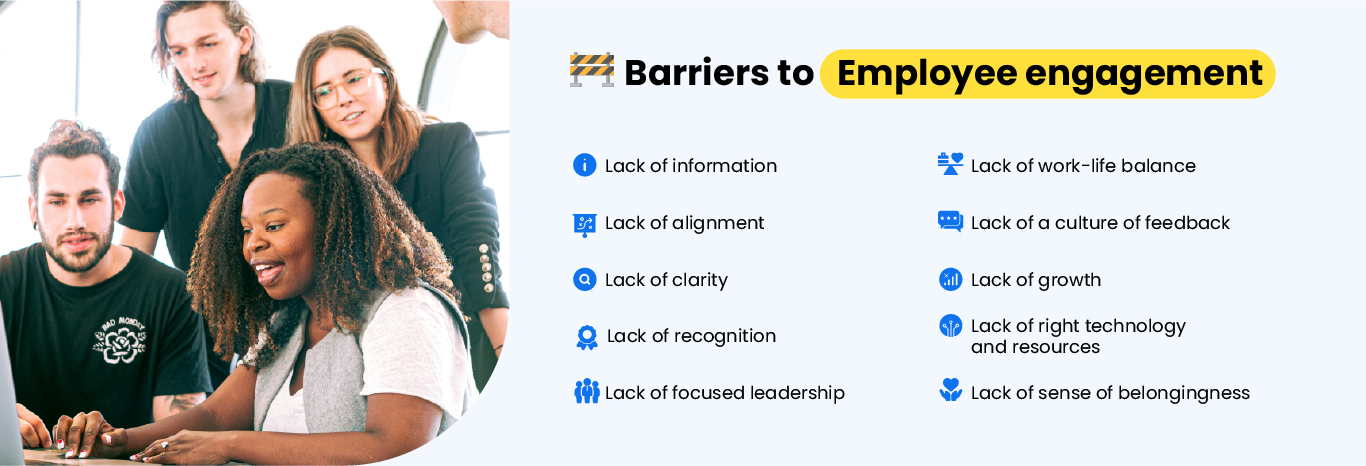In today’s business landscape, it is important to have a leg up on your competition and an easy way to go about it is to have well-engaged employees. In fact, employee engagement can make or break your company’s performance, impacting the overall bottom line.
To quickly recap, employee engagement describes an employee’s willingness to work diligently and be creative in supporting the company’s overall goals. For most companies, this is easier said than done. Changing work models and cultures have made it difficult to keep employees engaged.
The transition to remote work and then to hybrid work as a result of the pandemic is not just a logistical nightmare for organizations, but it also deeply impacts employee engagement levels. In times like these, if employee engagement is not a part of an organization’s business strategy, chances of it being successful are very bleak.
In this article, we will touch upon some of the most common barriers to employee engagement and how your organization can overcome them.
What are the barriers to employee engagement?

An organization’s challenges in employee engagement may vary based on their working model, type of work, and other variables.
But here are some barriers to employee engagement organizations usually face:
Lack of information
Lack of alignment
Lack of clarity
Lack of recognition
Lack of a focused leadership
Lack of work-life balance
Lack of a culture of feedback
Lack of growth
Lack of the right technology and resources
Lack of a sense of belongingness
 Lack of information
Lack of information
One of the challenges of employee engagement is an open channel of communication between organizations and employees. Employees want to know about their company’s vision, goals, achievements, road map, etc. Many companies still don’t find it necessary to share the company’s decisions, achievements, or setbacks with the employees. Such an environment makes your employees feel alienated and undervalued.
 Lack of alignment
Lack of alignment
Every business strategy trickles down from the larger company goals and objectives, and employee engagement is no different. If your employee engagement strategy is not aligned to your larger business goals, chances are its implementation and measurement are going to be one of the biggest barriers to employee engagement.
 Lack of clarity
Lack of clarity
If employees don’t have clarity about their job roles and responsibilities, or about specific tasks, they tend to get frustrated, making them less productive than they usually should be. Add to that an unapproachable manager, and you have the perfect barrier to employee engagement. Lack of clarity can result in a feeling of confusion, eventually impacting an employee’s performance and productivity.

 Lack of work-life balance
Lack of work-life balance
A major barrier to employee engagement is the lack of work-life balance. Employees will need leisure time to prioritize their own lives outside of work, and be recharged, revitalized, and ready for when it truly matters.
But many businesses create a workplace culture that doesn’t allow room for open communication and flexibility. When employees are refreshed and motivated to work, only then can they be productive. An unfriendly employee leave policy and little time to unwind is a red flag for your employee engagement levels. It can only result in burnout and attrition.

 Lack of a focused leadership
Lack of a focused leadership
This is one of the biggest barriers to employee engagement because it leads to a lack of trust, poor communication, and productivity. Since leaders and managers are the links between the organization and employee, their lack of focus while leading teams can give rise to employee engagement problems. This ultimately leads to dip in employee engagement and higher employee turnover rates.
 Lack of recognition
Lack of recognition
According to Glassdoor, 53% of employees have expressed their intention of staying longer in their current company if they feel more appreciated. In fact, one of the top reasons employees feel disengaged at work is that they feel undervalued in their workplace. When there is a clear lack of recognition, bigger barriers to employee engagement can seep in.

 Lack of a culture of feedback
Lack of a culture of feedback
Many companies don’t foster a culture of giving proper feedback. While you may feel it is easier to avoid tough conversations, it is imperative to understand how feedback affects the overall performance of your employees.
4 out of 10 employees who don’t receive proper feedback are more prone to disengagement at the workplace. By avoiding the difficult dialogue, you may make your employees feel as though their work doesn’t add any value.
 Lack of growth
Lack of growth
The lack of growth within the company acts as a major barrier to employee engagement. Currently, most growing companies lack a proper training program, which ties in heavily to the overall engagement of employees.
According to reports, 74% of employees feel that their full potential is underutilized due to the lack of development opportunities. Your employees are more likely to quit if they feel stagnated for a prolonged duration without any professional growth even after doing an amazing job.

 Lack of the right technology and resources
Lack of the right technology and resources
In a digital world, it is important to have the right technology and resources to work at one’s full potential. Without these, employees may feel frustrated, resulting in delayed tasks and a breakdown in communication. Efficient and easy to use tools are an employee’s best friend.
 Lack of a sense of belongingness
Lack of a sense of belongingness
If your employees don’t feel like they belong to the workplace, they will never go out of their way to accomplish their tasks and responsibilities. Your employees feeling out of place will negatively affect the comfort of all the employees. Needless to mention that without mutual trust and connection, teams can’t work in synergy.

What are some ways to overcome the barriers to employee engagement?
Every organization has its own challenges of employee engagement. Here are some actionable that HR leaders can undertake to increase employee engagement at the workplace:
 Ensure alignment at all levels
Ensure alignment at all levels
Since many of the challenges of employee engagement stem from a lack of alignment and information, ensure that your employees are aware of what’s happening in the organization and what are the organization’s future plans.
Creating a proper resource detailing the vision, mission, and values of your company and providing them to your employees is a good step to building alignment and belongingness. This way, they will feel part of a common goal and vision and work accordingly. This knowledge will provide them with the necessary information and help them provide better results in each task they take up as it is in synergy with the company’s goals.
 Address lack of clarity proactively
Address lack of clarity proactively
If you want your employees to be productive, they should have a clear idea of their job responsibilities, their progress, and the support they get to reach their goals. Start addressing employee engagement problems during pre-onboarding itself. When an employee comes on board, make it a point to help them understand their complete role. Show them a roadmap for their role, and a birds eye view of where their role fits in the organization.
Have a clearly defined onboarding strategy. Assigning a work buddy or a mentor will ensure that the new employee understands exactly what they are required to do. Managers should introduce new and existing employees into the complete picture. This way employees can clearly comprehend their individual roles, the role of their colleagues, as well as how their part contributes to the company’s vision.
 Make reward and recognition a common practice
Make reward and recognition a common practice
An effective employee recognition program yields visible growth in business. If employees are incentivized for their efforts, they try to do even better in the future.
Not only is positive recognition important to employees, but it can also be an active catalyst for the company’s growth. It increases an employee’s efficiency and productivity. People who feel appreciated do better work and experience less job dissatisfaction than those who feel under-rewarded.
Rewards and recognition are a small solution to a big employee engagement challenge.
Some ways to recognize your employees include offering a gift voucher, sending a thank you note, announcing their names in a town hall, or hosting an awards night at the annual company event. Performance-based bonuses are a great way to recognize and reward your employees. This will allow them to see that they are appreciated and that their hard work is paying off.
 Loop in the leadership
Loop in the leadership
Leadership and management teams need to lead from the heart. There is nothing more motivating than a genuine leader you can trust, and who trusts you. A leadership team that doesn’t prioritize employee engagement is the biggest barrier to employee engagement.
Having leadership buy-in at different levels of an employee engagement strategy increases its chances of success. Leadership involvement adds focus to your employee engagement program and reduces the challenges in employee engagement implementation.
As a leader, you can schedule town halls or even one-on-one meetings between the leadership and employees to align and enable them better. The more transparent they feel the leadership is, the more likely they are to find them aspirational.
 Promote and enable work-life balance
Promote and enable work-life balance
Start with setting realistic expectations so that employees do not work overtime. Allow them to support their interests and hobbies outside of work. Time spent on the job does not necessarily convert to productivity. Providing flexible work options during remote working or shifting to a hybrid work model will help promote a healthy work-life balance.
As an employer, make sure you understand the lives of your employees and what matters to them the most. Recognize their achievements in all aspects of life, events, and milestones outside of work, and start building a company culture that your employees will love.
 Active listening using the voice of the employee tools
Active listening using the voice of the employee tools
Your employees are crucial to your company’s success. So listening to them is just as important as listening to your customers. To overcome the challenges of employee engagement, it is necessary to give your employees a voice. But when you have a significantly bigger workforce, actively listening to and addressing grievances and suggestions of every employee becomes a mountainous task.
With the right voice of the employee tool in place, the task of listening to your employees and keeping records of the issues can be automated. This enables HR teams to take actions and corrective measures.

 Share feedback more often
Share feedback more often
Every time your employee completes a set of tasks, give them prompt feedback. Praise them for doing a good job and point out areas that need improvement. Such conversations will help you create a culture of trust, transparency, and open communication. As a result, your employees will have a better understanding of what is expected of them, eventually leading to higher engagement and productivity.
 Invest in tools, resources, and L&D
Invest in tools, resources, and L&D
Even if you do everything mentioned above, without the right resources and modern tools, your employee engagement strategy will be of no use. Invest in technology and proper resources to give your employees the chance to do their best every day. With smart resources and tools, you decrease the barriers to employee engagement and help them focus on productivity.
Investing in a proper learning and development plan for your employees is important if you want to keep up with the constantly upskilling global workforce. Dedicated L&D programs that help employees upskill and move up the ladder are a great way to keep your employees engaged. Giving them internal opportunities to move roles and take on additional responsibilities also help increase retention.
A comprehensive strategy to tackle employee engagement problems
The first step to creating a comprehensive employee engagement strategy is to figure out what engagement goals you would like to accomplish. This is where your larger business vision should be able to help you. Based on the goals, an employee engagement survey can be designed to kickstart your employee engagement initiatives. The survey feedback will give you actionable insights into the current status of every employee in your company and indicate employee engagement challenges so that you can take well-informed decisions and make better employee engagement plans.
Once you have the insights from your employee surveys, the next step is a comprehensive recognition program. When employees feel recognized, rewarded, and valued, job satisfaction increases, and productivity levels rise.
Sending timely notifications to employees about any major update or achievement regarding the company is a good strategy to boost morale. This will also help increase their feelings of belongingness within the company and create an even better environment for them to be more successful, making recruiting and retaining talent easier.
Summary
Poor employee engagement is a financially hefty problem. Statistically, it costs businesses an average of $4129 to hire new talent.
Getting the most out of employee engagement is in itself a challenge of employee engagement. The way to a successful employee engagement is laid with barriers and roadblocks, but the most common barriers to employee engagement are often overlooked. However, workplaces that value employees successfully eliminate these barriers to employee engagement through better communication, alignment, flexibility, resources, etc.






